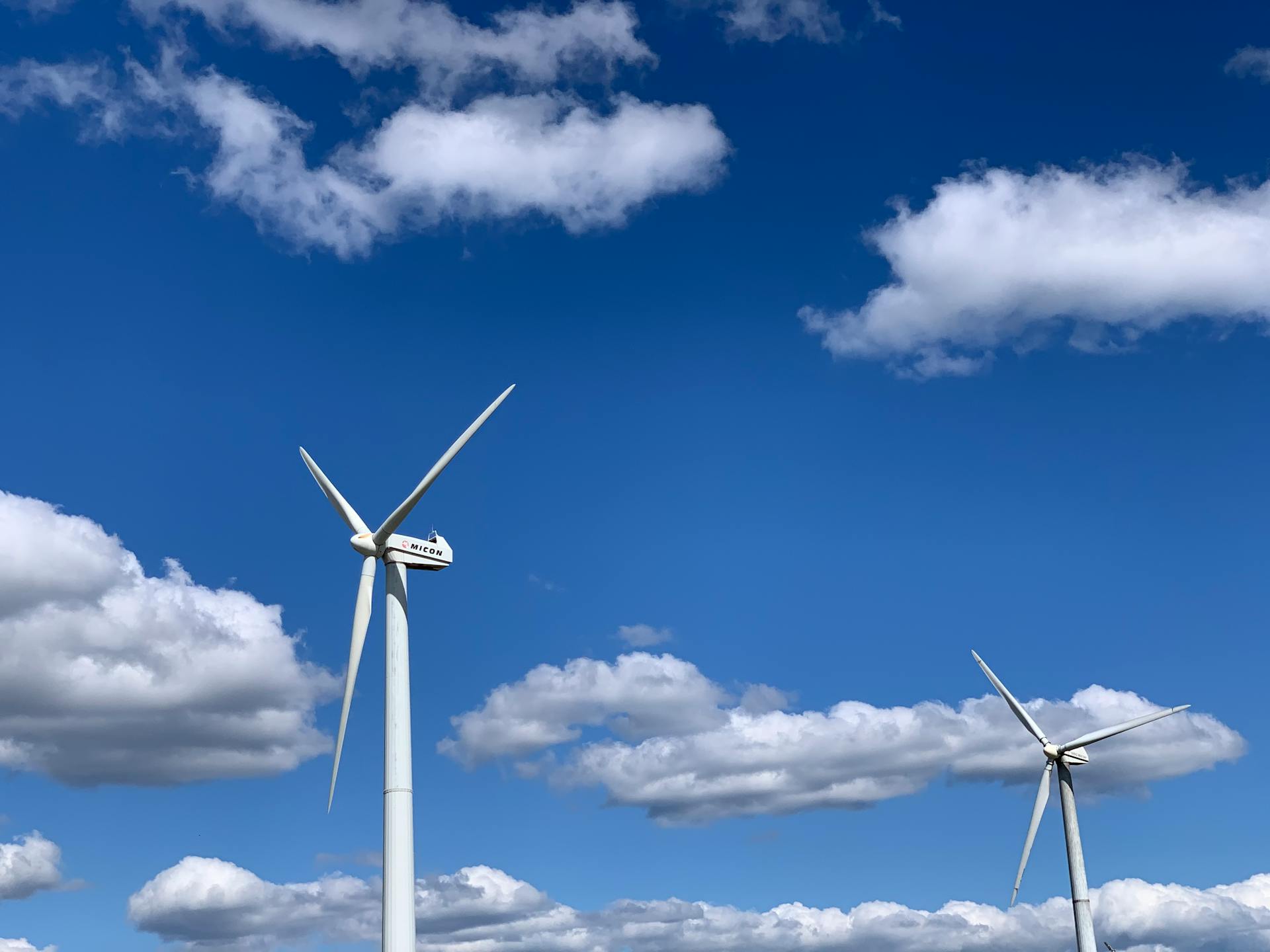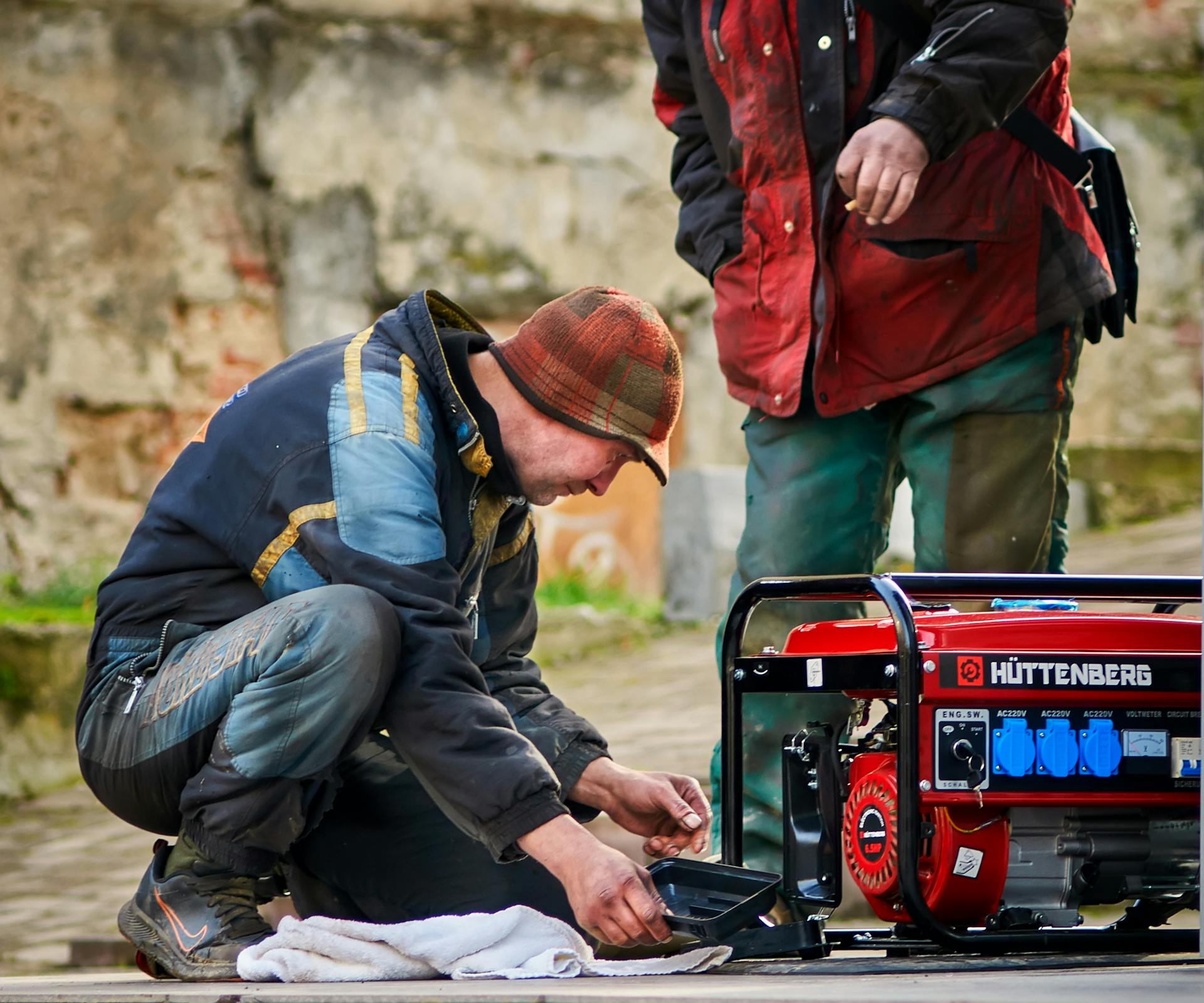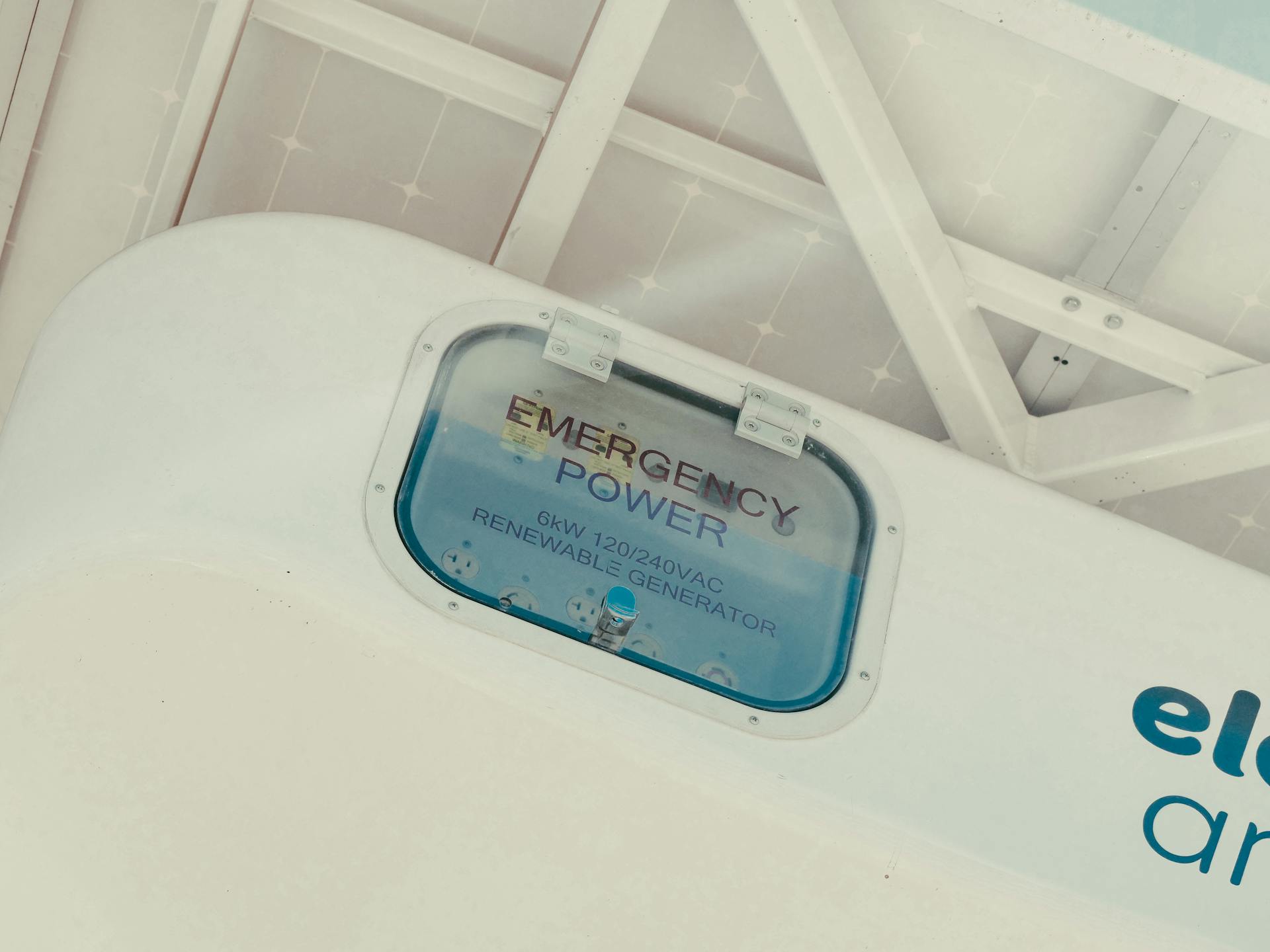
AC generators are a crucial part of modern technology, and understanding how they work is essential for anyone interested in electricity.
AC generators, also known as alternators, convert mechanical energy into electrical energy, producing alternating current.
They're commonly used in power plants to generate electricity for homes and businesses.
AC generators can also be found in smaller forms, such as in portable generators and even in some vehicles.
Construction and Components
The construction of an AC generator involves several key components that work together to produce electricity. The field is made up of conductor coils that receive electricity from the source and generate magnetic flux.
The armature is a crucial part of the AC generator, producing the output voltage. It's composed of wire coils large enough to handle the generator's full-load current.
The prime mover is the component that drives the AC generator, and it can be a diesel engine, a steam turbine, or a motor.
The rotor is the rotating component of the generator, driven by the generator's prime mover.
The stator is the stationary component of the AC generator, made up of a lamination of steel alloys or magnetic iron to minimize eddy current losses.
The slip rings are electrical connections that transfer power to and from the rotor of the generator.
Here's a breakdown of the main components of an AC generator:
The rotor rotates through an axis perpendicular to the magnetic field, and it's connected to the slip rings and carbon brushes. The stator core is made up of a lamination of steel alloys or magnetic iron to minimize eddy current losses.
Working Principle and Types
The working principle of an AC generator is based on the law of electromagnetic induction, which states that a current-carrying conductor experiences a force due to the interaction between the conductor and the magnetic field. This force induces an electromotive force (EMF) in the conductor, which is the fundamental principle behind the operation of an AC generator.
The operation of an AC generator involves the rotation of a coil within a magnetic field, causing a change in the magnetic flux linked with the coil. This change in magnetic flux induces an EMF in the coil, resulting in the generation of an electric current. The direction of the induced current can be determined using Fleming's Right-Hand Rule.
AC generators are generally of two types: single-phase AC generators and three-phase AC generators. A single-phase AC generator converts mechanical power into single-phase electric power, while a three-phase AC generator converts mechanical power into three-phase electric power.
If this caught your attention, see: Single-phase Generator
Field
The field of an AC generator is made up of coils of conductors that receive a voltage from the source and produce magnetic flux.
The magnetic flux in the field is what cuts the armature to produce a voltage, which is the output voltage of the AC generator.
The field is a crucial component of the AC generator, as it allows for the conversion of mechanical energy into electrical energy.
A different take: Does a Generator Produce Ac or Dc
A coil spinning in a magnetic field or moving relative to a magnet generates an electromotive force (emf) or potential difference.
The magnetic field intensity and rotating field speed determine the EMF generated in the AC generator.
Increasing or decreasing the number of magnetic flux lines that pass through a wire's coil can also affect the EMF generated.
Working Principle
The working principle of an AC generator is based on the principle of electromagnetic induction. This phenomenon was discovered by Michael Faraday, who found that a current-carrying conductor experiences a force when placed in a uniform magnetic field.
The AC generator consists of an armature coil that is placed between two poles, and the armature coil is made to rotate in the magnetic field of the poles. As the armature coil rotates, the flux associated with the coil changes, inducing an electric current.
The direction of the induced current can be determined using Fleming's Right-Hand Rule, which states that the first finger points in the direction of the magnetic field, the thumb in the direction of conductor velocity, and the middle finger in the direction of induced current.
Take a look at this: Direct Current Electric Generator
The AC generator produces an alternating current, which is measured by the galvanometer. The sign of the current changes from positive to negative in each rotation, indicating that the current is alternating.
The AC generator works on the principle of electromagnetic induction, which is governed by two laws established by Faraday: the induced emf persists for as long as the magnetic flux varies, and the amplitude of induced emf is proportional to the rate of change of magnetic flux.
Here are the main components involved in the working principle of an AC generator:
- Armature coil
- Magnetic field
- Galvanometer
- Fleming's Right-Hand Rule
These components work together to produce an alternating current, which is a fundamental aspect of the AC generator's working principle.
Types
There are two main types of AC generators: single-phase and three-phase. A single-phase AC generator converts mechanical power into 1-phase electric power alternating current by electromagnetic induction.
A three-phase AC generator is an electrical machine that converts mechanical power into three-phase power alternating current by electromagnetic induction. This type of generator is commonly used in industrial settings.
Explore further: Dc Electromagnetic Generator
The three-phase AC generator has three conductors, each carrying an alternating current of the same frequency and voltage amplitude relative to a common reference, but with a difference of one third the period.
In a three-phase AC generator, the common reference is usually connected to the ground and a neutral conductor. This setup allows for efficient transmission and utilization of power.
Consider reading: Three Phase Ac Generator
Advantages and Disadvantages
AC generators have several advantages that make them a popular choice for electricity generation. They are more efficient than DC generators, converting more mechanical energy into electrical energy. AC generators are also simpler to design and build, with fewer moving parts. This simplicity makes them more reliable and less prone to breakdowns.
AC generators can be easily stepped up and stepped down through transformers, making them ideal for long-distance transmission. This feature reduces the size of the transmission link, making it thinner and more efficient. Additionally, AC generators have lower losses compared to DC machines, resulting in more power output. They are also generally smaller in size, making them easier to carry and set up.
Here are some key advantages of AC generators:
- Efficiency: AC generators are more efficient than DC generators.
- Transmission: AC can be transmitted over long distances with low losses using transformers.
- Cost: AC generators are generally less expensive than DC generators of the same capacity.
- Simplicity: AC generators are simpler to design and build than DC generators.
- Reliability: AC generators are more reliable than DC generators because they have fewer moving parts.
Advantages
AC generators have several advantages over DC generators. One of the main advantages is that they can be easily stepped up and stepped down through transformers, making them ideal for long-distance transmission with low losses.
AC generators are more efficient than DC generators, meaning they can convert more mechanical energy into electrical energy. This is due to the fact that AC generators have fewer losses compared to DC machines.
The transmission link size in AC Generators is thinner because of the step-up feature, making them more convenient to use. AC generators are generally less expensive than DC generators of the same capacity.
AC generators are simpler to design and build than DC generators because they do not require a commutator, which is a complex and moving part. This simplicity makes them more reliable than DC generators, which have fewer moving parts.
AC generators provide a choice of generating electricity at different frequencies, which is useful in certain devices and can be controlled by changing the design of the generator.
Here are some of the key advantages of AC generators over DC generators:
- Efficiency: AC generators are more efficient than DC generators.
- Transmission: AC can be transmitted over long distances with low losses using transformers.
- Cost: AC generators are generally less expensive than DC generators of the same capacity.
- Simplicity: AC generators are simpler to design and build than DC generators.
- Reliability: AC generators are more reliable than DC generators because they have fewer moving parts.
AC generators are generally smaller in size as compared to DC generators, making them easier to carry and set in any location. This is due to the fact that they can be easily stepped up and stepped down using transformers.
Disadvantages
AC generators have their downsides, and it's essential to consider them before making a decision.
They're susceptible to sparks and heating issues, which can lead to electric shocks and even fires.
Voltage fluctuations are another issue, as they can cause problems for some electronic devices.
AC generators often require transformers to step up or step down the voltage, adding to the cost and complexity of the system.
AC generators can be a bit more complex to control than DC generators, thanks to their additional features like voltage and frequency control.

Higher maintenance requirements are also a drawback, as AC generators can suffer from machine breakdowns and fluctuations more often.
In addition, AC generators are only useful for high loads, and low loads can lead to decreased efficiency and increased fuel consumption.
Another consideration is that AC generators can experience voltage drops when transmitting power over large distances due to the resistance in transmission lines.
AC generators that operate at high frequency can also be a source of potential hazard, causing electric shocks if handled carelessly.
Frequently Asked Questions
What size generator do I need to run house AC?
For a 3-ton AC, a 6,500-8,500 watt generator is recommended, while a 7500-watt generator is ideal. For a 4-ton AC, a 8,000-10,500 watt generator is needed.
Can any AC motor be used as a generator?
Most AC induction motors can be used as generators without modifications, but it depends on the motor's design and intended application
Sources
- https://byjus.com/physics/ac-generator/
- https://testbook.com/physics/ac-generator
- https://www.geeksforgeeks.org/ac-generator-principle-construction-working-applications/
- https://www.geeksforgeeks.org/applications-of-ac-generator/
- https://www.toppr.com/guides/physics/electronics/ac-generator-definition-and-parts-of-ac-generator/
Featured Images: pexels.com


